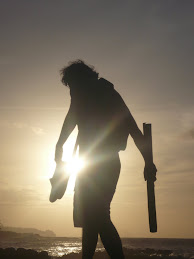Photo: Sticky white rice growing in a streamside taro patch on Oahu, photo courtesy Hunter Heaivilin.
After years working overseas in the Solomon Islands, Fiji, and now Vanuatu, ADRA Country Director David Cram refers to white rice as 'the scourge of the Pacific', and for good reason.
Polynesian cultures brought many of their sustenance plants with them as they migrated - the so-called
canoe plants - and their cultivation practices both evolved with and shaped their lands.
Photo: Taro under wet cultivation at Reppu's Farm in Waiahole Valley, Oahu (Hawaii) [photo credit: Pete Hodgson].
Taro, yams, and sweet potatoes were the staple crops of these peoples, supplemented by animal proteins from fish, fowl & pigs.
White rice, although popular with modern polynesian cultures, was never a part of the traditional polynesian diet.
After generations of co-evolving with extensive taro cultivation (cultivating a relationship with a staple food that Hawaiians regard as their 'older brother') in recent generations Hawaiian food culture has shifted to include a mishmash of cultural influences which manifest itself in the local favorite of the 'plate lunch':
Photo: Courtesy of cougareats.blogspot.com.au. Two scoops white rice, one scoop mac salad, a bed of shredded cabbage (if you are lucky), and then whatever local-style meat dish: chicken cutlet smothered in brown grazy, teri-beef drowning in sugary teriyaki sauce, fried fish glob bed with mayonaise-based tartare sauce… and almost anything else you could imagine.
The results of this change in diet & lifestyle have been dire: Polynesians rank significantly above other ethnic groups in
Non Communicable Disease (NCD) categories such as diabetes, obesity, and other related 'lifestyle diseases'.
In fact, Polynesians that have maintained traditional diets have maintained obesity rates lower than those of Western Populations. (1)
Photo: Harvesting taro at Reppu's Farm in Waiahole Valley, Oahu (Hawaii) [photo credit: Pete Hodgson].
Once you've spent some time working in a lo'i (wet cultivation taro patch) it's not hard to imagine how this seemingly simple shift in diet has contributed to such dis-ease:
First, the amount of calories you would burn in the daily course of planting, tending, harvesting & processing your family lo'i would have been significantly higher than the amount of calories burnt by the average modern person purchasing a package of white rice and boiling it up at home.
Second, if we understand how white rice is created, we may decide to change our relationship with that food. Rice is harvested as a grain crop - much in the same way as wheat, rye or barley - it goes as a tall grass, and its seed heads are threshed and winnowed to separate the grains from the rest of the plant.
Photo: White rice grains. Simply put, each grain of rice is held inside an outer protective hull, and the inner layer(s) of the pericarp adds more protective layers - this is the rice bran.
Most of the nutrients available in rice are stored here; the grain itself acts as an energy store for the plant embryo inside and is designed to give it it's initial burst of energy to sprout forth its roots & shoots, to then absorb & create its own nutrients from the soil & sun.
White rice is created by removing this protective skin, and polishing the grains so that they are more attractive, and become soft & fluffy when cooked.
Third, because white rice is mostly made of carbohydrates, it is converted by the body into sugars (click
here for a more detailed explanation, which will cause havoc if they are not used up by the body through physical exercise… not exactly a good combination for the average, modern, sedentary lifestyle.
A facilitated class discussion was held in an attempt to give students a deeper understanding of this food, so that we could understand the impacts of white rice overconsumption:
- What is white rice?
- How many of you eat white rice? How many of you grow white rice?
- How does it grow? Where does it come from?
- How does it get here?
- How does it affect your health?
Next, we brainstormed alternatives to this locally popular imported food:
- Reduce portion size
- Balance servings with traditional foods
- Create new white rice dishes using local ingredients:
white rice cooked in coconut milk
white rice mixed w/ grated coconut
white rice mixed w/ ginger & onion
white rice mixed w/ seasalt/seaweed
white rice mixed w/ grated yellow ginger (turmeric) & canarium nut...
....this list is limited only by our imagination, and taps into the creative energy of human innovation, a much more effective strategy to affect behavioural change than dire health warnings and finger-wagging public lectures. Who doesn't like to hear about a great new recipie?
If it tastes good - we humans love it - so a permacultural approach looks as this as an energy flow we design with, rather than work against.
Overconsumption of white rice is not a good thing - especially in these communities - but it is already there, so we work to redirect & deflect this energy rather than put all our effort into fighting against it, and focus our design efforts towards long-term systemic improvement rather than knee-jerk symptomatic reponses.
______________________________________________
(1) 'The Obesity Epidemic in the Pacific Islands', Michael Curtis (United States Department of Army); Journal of Development and Social Transformation

